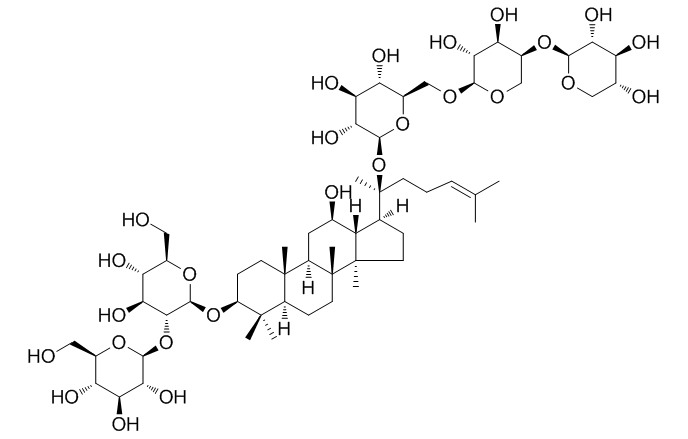Ginsenoside Ra1
Ginsenoside Ra1 shows significant inhibitory effects on protein tyrosine kinase (PTK) activation induced by hypoxia/reoxygenation (H/R).
Inquire / Order:
manager@chemfaces.com
Technical Inquiries:
service@chemfaces.com
Tel:
+86-27-84237783
Fax:
+86-27-84254680
Address:
1 Building, No. 83, CheCheng Rd., Wuhan Economic and Technological Development Zone, Wuhan, Hubei 430056, PRC
Providing storage is as stated on the product vial and the vial is kept tightly sealed, the product can be stored for up to
24 months(2-8C).
Wherever possible, you should prepare and use solutions on the same day. However, if you need to make up stock solutions in advance, we recommend that you store the solution as aliquots in tightly sealed vials at -20C. Generally, these will be useable for up to two weeks. Before use, and prior to opening the vial we recommend that you allow your product to equilibrate to room temperature for at least 1 hour.
Need more advice on solubility, usage and handling? Please email to: service@chemfaces.com
The packaging of the product may have turned upside down during transportation, resulting in the natural compounds adhering to the neck or cap of the vial. take the vial out of its packaging and gently shake to let the compounds fall to the bottom of the vial. for liquid products, centrifuge at 200-500 RPM to gather the liquid at the bottom of the vial. try to avoid loss or contamination during handling.
Chem Biol Interact.2016, 258:59-68
Exp Neurobiol.2018, 27(3):200-209
J Am Soc Mass Spectrom.2021, 32(5):1205-1214.
Biotechnology and Bioprocess Engineering2024, 29:1048-1060.
Food Sci Biotechnol.2024, 34(3):611-620.
Planta Med.2019, 85(9-10):766-773
Eur J Pharmacol.2023, 960:176121.
Int Immunopharmacol.2020, 90:107268.
Inflammation.2021, doi: 10.1007
Biomolecules.2024, 14(5):589.
Related and Featured Products
Planta Med. 2001 Feb;67(1):19-23.
The inhibitory effects of ginsenosides on protein tyrosine kinase activated by hypoxia/reoxygenation in cultured human umbilical vein endothelial cells.[Pubmed:
11270715]
METHODS AND RESULTS:
27 individual ginsenosides and aglycones, together with five extracts from ginseng roots, ginseng leaves, American ginseng roots, American ginseng leaves and non-saponin fraction from roots of Panax ginseng, were tested for their effects on protein tyrosine kinase (PTK) activation induced by an in vitro hypoxia/reoxygenation (H/R) model in cultured human umbilical vein endothelial cells (HUVEC).
The results indicated that ginsenoside Rb1 (3), ginsenoside Rd (7), Ginsenoside Ra1 (1) and ginsenoside Ro (27) showed significant inhibitory effects on PTK activation induced by H/R.
Dose-response experiments revealed that ginsenoside-Rb1 was the most active compound and it completely blocked PTK activation at a wide range of concentrations.
CONCLUSIONS:
Most protopanaxadiol-type ginsenosides and some protopanaxatriol-type saponins also showed significant effects on PTK activation. However, the crude extracts did not protect against H/R-induced PTK activation.
Zhongguo Zhong Yao Za Zhi. 2013 Sep;38(17):2807-17.
Chemical constituents from roots and rhizomes of Panax ginseng cultivated in Jilin province.[Pubmed:
24380303]
METHODS AND RESULTS:
The chemical constituents of the roots and rhizomes of Panax ginseng were systematically investigated by various column chromatographic methods including Amberlite XAD-4 macroporous adsorptive resins and silica gel as well as high-performance liquid chromatography, and their chemical structures were identified by physico-chemical properties and spectral analyses.
Twenty-eight compounds were isolated from the 70% ethanolic-aqueous extract and identified as koryoginsenoside R1 (1), ginsenoside Rg1 (2), ginsenoside Rf (3), notoginsenoside R2 (4), ginsenoside Rg2 (5), notoginsenoside Fe (6), ginsenjilinol (7), ginsenoside Re5 (8), noto-ginsenoside N (9), notoginsenoside R1 (10), ginsenoside Re2 (11), ginsenoside Re1 (12), ginsenoside Re (13), ginsenoside Rs2 (14), ginsenoside Ro methyl ester (15), ginsenoside Rd (16), ginsenoside Re3 (17), ginsenoside Re4 (18), 20-gluco-ginsenoside Rf (19), ginsenoside Ro (20), ginsenoside Rc (21), quinquenoside-R1 (22), ginsenoside Ra2 (23), ginsenoside Rb1 (24), Ginsenoside Ra1 (25), ginsenoside Ra3 (26), ginsenoside Rb2 (27), and notoginsenoside R4 (28). All isolated compounds are 20 (S) -protopanaxadiol or protopanaxatriol type triterpenoid saponins.
CONCLUSIONS:
Compound 1 was isolated from the roots and rhizomes of P. ginseng cultivated in Jilin province for the first time and compound 6 was isolated from the roots and rhizomes of P. ginseng for the first time. The 1H-NMR data of compounds 6, 14 and 19 were assigned for the first time.



